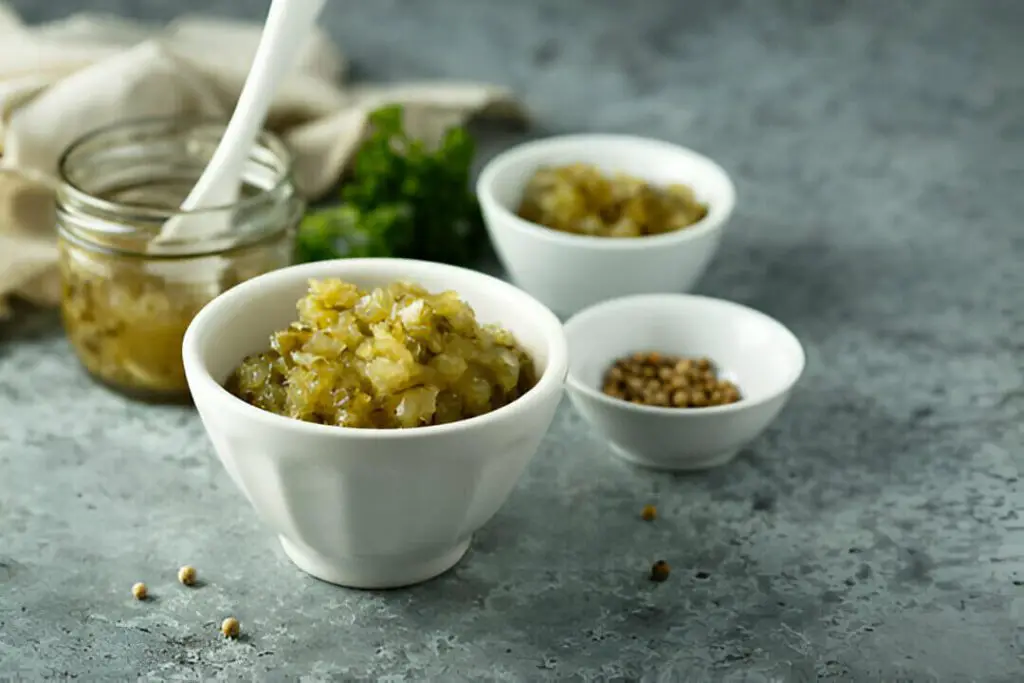Let’s be real, we’ve all been there—reaching for that trusty jar of relish in the fridge only to be hit with a whiff of something funky. Suddenly, you’re questioning everything you thought you knew about shelf life and food safety. Is it still good? How long has it been in there? Does relish go bad? The anxiety is real, folks!
Whether you’re a die-hard fan of the classic dill pickle relish or prefer to mix it up with zesty chutney varieties, understanding when our beloved condiments have turned is a crucial life skill. After all, nobody wants to ruin a perfectly good hot dog or burger with a side of food poisoning.
So, grab a napkin and get ready to take notes, because we’re diving deep into the world of relish expiration dates. From spotting the telltale signs of spoilage to maximizing freshness, this guide has got you covered. Who knows, you might even impress your friends with your newfound condiment wisdom at the next backyard barbecue! Let’s do this.
What is Relish?
At its core, relish is a tangy, flavor-packed condiment made from chopped pickled cucumbers, vegetables, and a blend of savory spices and seasonings. It’s the perfect way to add a vibrant pop of flavor and crunch to all sorts of dishes, from hot dogs and burgers to deli sandwiches and even roasted meats.
But relish is more than just a one-trick pony; this versatile topping comes in a delicious array of styles and varieties. The most common and recognizable is probably the classic dill pickle relish, made by finely dicing up crisp, briny dill pickles and combining them with a zingy blend of vinegar, salt, and dill weed. You’ll often find this green relish sitting pretty alongside ketchup and mustard at barbecue joints and diners across the country.
Then you’ve got sweet pickle relish, where bread and butter-style tangy-sweet pickles get the star treatment. Sweet relish is a staunch Southern favorite, beloved for cutting through the richness of dishes like deviled eggs, potato salad, and creamy coleslaws.
But the relish world extends far beyond the pickle realm too. Chutney is a popular type of relish that originated in India, made by cooking down fruits like mango or tomato with vinegar, aromatics like onion and garlic, and a myriad of spices like cumin, coriander, and chili peppers. The result is a chunky, highly seasoned spread that adds incredible depth of flavor to curries, rice dishes, and grilled proteins.
On the less exotic side, corn relish delivers a taste of summer with diced kernels of sweet corn, bell peppers, onions, and vinegar. It makes an unbeatable hot dog topper and can even be used as a crisp, tangy bruschetta topping for crostini.
Does Relish Go Bad?
Yes, relish can indeed go bad. Like many food items, relish is susceptible to spoilage over time, especially once the jar has been opened.
Shelf Life of Relish
When it comes to relish shelf life, the cardinal rule is this: unopened jars keep much, much longer than opened ones. An unopened jar of store-bought relish can maintain peak flavor and quality for up to 2 years past the printed date if stored correctly.
Proper storage for sealed jars is key to maximizing shelf life. Relish loves a cool, dark environment – the refrigerator is ideal, but a pantry or cupboard away from heat sources will also do the trick. Avoid humidity or dampness at all costs, as this can cause lids to corrode and ruin the seal. Generally, you’ll know the seal’s been compromised if you hear a hissing sound when opening the jar.
Once that lid comes off, though, the clock starts ticking. An opened jar of relish should keep for 3–44 months in the fridge. That briny vinegar brine acts as a preservative, but air exposure causes the relish to gradually lose crispness, flavor, and color vibrancy over time.
For homemade or freshly purchased refrigerated relishes from the deli, that window shrinks to more like 1 month at best. These fresher varieties lack the heavy-duty preservatives and pickling power that give jarred, shelf-stable relish its impressive longevity.
No matter if it’s store-bought or homemade, always make sure to store opened relish jars sealed tightly with a lid and chilled in the fridge. The cool temperatures drastically slow down bacterial growth and quality degradation. Room temperature is a big no-no, as it will cause relish to spoil much faster.
Signs That Relish Has Gone Bad

Even with proper refrigeration, no relish can stay fresh forever. Over time, it will start showing signs that it has officially crossed over into “no longer fit for human consumption” territory. Recognizing these indicators is crucial for avoiding potential food poisoning.
One of the biggest red flags is the appearance of mold or fungus growth. This can manifest as fuzzy green, black, or white spots on the surface of the relish or around the inner lid area. Mold spores can circulate throughout an entire jar extremely quickly, so even a small amount warrants tossing the whole thing. Don’t try scooping out just the moldy parts – that puts you at risk of ingesting mold toxins.
Another major sign of spoilage is an abnormal color change. Fresh relish should maintain a vivid, eye-catching green (dill), red (sweet), or orangey-red (chutney) hue. But as it deteriorates, the colors start looking muddied, murky, and drab. For instance, dill relish may fade to an ugly olive brown or green-grey shade as it oxidizes.
You’ll also want to check the liquid at the bottom of the jar; cloudy, filmy, or evaporated brine is not a good sign. Fresh relish brine should remain clear and plentiful.
Take a whiff while you’re at it, because unpleasant odors are another major warning sign. Rotten, vinegary, or generally “off” smells signal the presence of spoilage bacteria and molds that can cause foodborne illness. Relish should simply smell bright, tangy, and fresh—never sour or funky.
Finally, take a look at the texture and consistency. Properly preserved relish should have a crisp, crunchy bite to the vegetable pieces. A total loss of crunch, turning mushy or slimy, indicates it’s way past its prime. You may also see excess liquid at the bottom, indicating that the ingredients have started breaking down.
If you notice any combination of these unfortunate signs, it’s best to discard the entire jar without tasting it. Don’t try to salvage it or pick out “the good parts”; improperly preserved relish can harbor pathogenic bacteria like salmonella or listeria. When in doubt, it’s better to be safe than sorry with your condiments!
Food Safety Concerns
While relish may seem like a pretty innocuous condiment, the risks of consuming spoiled or contaminated relish are very real and shouldn’t be taken lightly. Foodborne illnesses caused by pathogenic bacteria, molds, and toxins are no joke.
The most common culprits when it comes to spoiled relish are bacteria like salmonella, E. coli, and listeria. These nasty microbes can multiply rapidly in low-oxygen, preservative-free environments—exactly the conditions relish sits in once a jar is opened. Consuming foods tainted with salmonella or E. coli can lead to symptoms like nausea, vomiting, diarrhea, abdominal cramps, and fever. Listeria is especially scary, capable of causing serious infections in pregnant women, newborns, older adults, and those with weakened immune systems.
Another concern with spoiled relishes are mycotoxins, which are potent toxins produced by certain molds like aspergillus. Ingesting foods contaminated with these toxins can cause acute food poisoning and gastrointestinal issues in the short term. However, studies show that chronic, long-term exposure to mycotoxins may potentially increase the risk of certain cancers and other adverse health effects down the road.
Even relish that appears perfectly normal can harbor these invisible threats to food safety. That’s why it’s so important to closely adhere to best-by dates on jars and to promptly refrigerate after opening. The cooler temperatures and acidity help inhibit microbial growth.
So what happens if you accidentally ingest some not-so-fresh relish before realizing it’s turned? For most healthy adults, it will likely just mean a bout of unpleasant vomiting and diarrhea as your body works to expel the offending pathogens. But for vulnerable groups like young children, the elderly, pregnant women, or anyone with a compromised immune system, the consequences can potentially be far more severe.
When in doubt, don’t risk it with spoiled relish! The relatively low cost of replacing a jar is well worth avoiding a nasty bout of food poisoning or even hospitalization in a worst-case scenario. Use your best judgment and refer back to those spoilage signs covered earlier. If something seems off, it’s always better to err on the side of caution.
Tips for Prolonging Relish Freshness

Now that we’ve covered all the frightening “what ifs” of letting relish linger too long, let’s talk about some simple tips and tricks for making sure your condiment stash stays fresh and delicious for as long as possible.
Proper storage is key from the moment you bring that jar home from the grocery store. Aim to stash unopened jars somewhere cool, dry, and dark until you’re ready to crack the seal. Spaces like a pantry cabinet or basement are great options. Avoid prolonged storage in warm, humid areas like right above the stove or under a window getting direct sunlight.
Once opened, get that relish into the fridge ASAP. Keeping it chilled at 40°F or below greatly slows down the growth of spoilage microbes and enzymes that degrade quality over time. Make sure to give jars a bit of breathing room too; overcrowding can lead to uneven cooling.
Using a clean utensil every time you dip into an open jar also helps minimize bacterial contamination that could shorten shelf life. Those germs love to hitch rides on knives and spoons! Designating a dedicated relish utensil that doesn’t get used for anything else is a smart move.
Air exposure is another enemy of freshness, so try not to leave that jar sitting open on the counter for too long after each use. The oxidation process will start degrading the vibrant colors and flavors quickly. When not in use, make sure that lid gets sealed on tight to minimize air pockets.
If you end up with too much leftover relish to realistically use up within a few months, don’t toss it! Relish actually freezes quite well for later use. Just transfer it into an airtight, freezer-safe container or bag, removing as much air as possible. It should keep for 6–12 months frozen this way without major quality loss. Allow it to thaw overnight in the refrigerator when you’re ready to use it again.
For the relish connoisseurs out there, you may want to keep a Sharpie pen handy for dating those jars when they are first opened. Having an easy reference point will let you know at a glance if it’s been hanging around a little too long in the back of the fridge.
FAQs
Does Refrigeration Affect Shelf Life?
An unopened jar of shelf-stable relish can be stored at room temperature just fine. However, once opened, refrigeration is absolutely essential for maximizing shelf life. The cool temperatures significantly slow down the growth of bacteria, yeasts, and molds that cause spoilage. Leaving an open jar of relish at room temperature will cause it to degrade and spoil much faster.
Can You Freeze Relish to Extend Shelf Life?
Yes, freezing is a great way to prolong the life of opened relish jars you can’t finish in time! Transfer any leftovers to an airtight, freezer-safe bag or container. When frozen, relish can last 6-12 months with minimal quality loss. Just thaw overnight in the fridge before using.
Is Homemade Relish More Perishable?
Absolutely. Commercially jarred relishes contain preservatives that help inhibit microbial growth. Homemade or fresh refrigerated relishes from the grocery store or farmers’ market lack these preservatives, so they have a much shorter shelf life of around 1-2 weeks in the fridge even if properly stored.
Can You Use Expired Relish for Cooking/Canning?
Using expired, spoiled relish as an ingredient is never recommended due to food safety risks. While the high heat involved in canning may kill off pathogens, you could still make yourself sick from ingesting the toxins produced by molds or bacteria. It’s best to discard any jars where the relish seems off.
What About Separation or Discoloration?
Some separation between the brine and solids is normal, especially towards the bottom of the jar. As long as the liquid is still clear and there isn’t major discoloration, it’s likely still fine. However, cloudiness, significant liquid evaporation, or the relish taking on a very drab or dull color can indicate spoilage.
Is There a Way to Tell If Relish is Bad Without Opening It?
Unfortunately, there’s no sure-fire way to assess freshness without cracking the seal. Look for signs like a bulging lid, leakage, or mold growth along the lid gasket as potential indicators that something has gone wrong inside. Otherwise, the best bet is to go by the”best by” date from the manufacturer as an estimate.
What If I Left an Opened Jar Out Overnight?
If an opened jar of relish is left at room temperature for more than 4 hours, it’s best to discard it. Relish can quickly become a breeding ground for bacteria once it reaches the “danger zone” temperatures between 40°F and 140°F for an extended period. Don’t risk food poisoning – when in doubt, throw it out.
Does Pickle Relish Last Longer Than Other Kinds?
Yes, the high vinegar and salt content in pickle relish acts as a natural preservative. An unopened jar can often last 3-5 years past its best-by date if stored properly. Other relish varieties, like chutney or pico de gallo, may only keep for 1-2 years unopened due to their lower acidity.
Is it Safe to Scrape Off Mold and Eat the Rest?
No, the presence of any visible mold means the entire contents of the jar should be discarded. Mold has toxic roots that penetrate deep into the relish – you can’t just remove the visible part. Even a tiny amount can make you ill if ingested.
Will Relish Expand or Bubble If It Spoils?
Bubbling, bulging, or leaking from a sealed jar can be signs of active fermentation or gaseous buildup occurring inside due to bacterial growth and spoilage. If the seal appears compromised, it’s better to be safe and not consume the contents.
My Relish Turned Brown—Is It Still Okay?
If a fresh green dill relish has taken on an unappealing brownish-olive tint, that likely indicates oxidation has occurred and the product is no longer fresh. Strong discoloration is a typical marker that the enzymes, pigments, and other compounds have significantly degraded over time.
What’s the White Stuff at the Bottom?
A powdery sediment, crystallization, or film forming at the bottom of the jar is usually just a harmless buildup of salt and mineral solids from the brine solution. As long as there’s no mold and the liquid above is still clear, it should be safe to consume if the relish itself looks and smells normal.
Conclusion
From backyard barbecues to ballpark hot dogs, relish is one condiment that adds a punch of flavor and texture to so many of our favorite savory foods. But as we’ve learned, even something as seemingly innocuous as a jar of pickled veggies can potentially harbor some serious food safety risks if not handled properly.
The key takeaways of this “Does Relish Go Bad” article? Pay close attention to those expiration dates on jarred relishes, and don’t try to stretch their shelf life much beyond a few months once opened. Refrigeration is absolutely essential for keeping spoilage at bay. And when in doubt, rely on your senses; any sign of mold, off odors, or significant texture and color changes is a surefire indicator that it’s time to part ways with that jar.
At the end of the day, no amount of tangy, crunchy goodness is worth a bout of food poisoning. Don’t let yourself or your loved ones become one of the 48 million yearly cases of foodborne illness! A little diligence about monitoring freshness can go a long way.
That said, relish is still a deliciously versatile way to liven up meals when it’s fresh and properly preserved. So don’t be afraid to stock up on your favorite varieties! Just be sure to take the right storage precautions and stay on top of rotating jars as they get opened.
With this complete guide under your belt, you can stride confidently through your next condiment aisle visit and be the master of your relish domain. Here’s to many more crunchy, zingy, fear-free hot dog toppings in the future!



